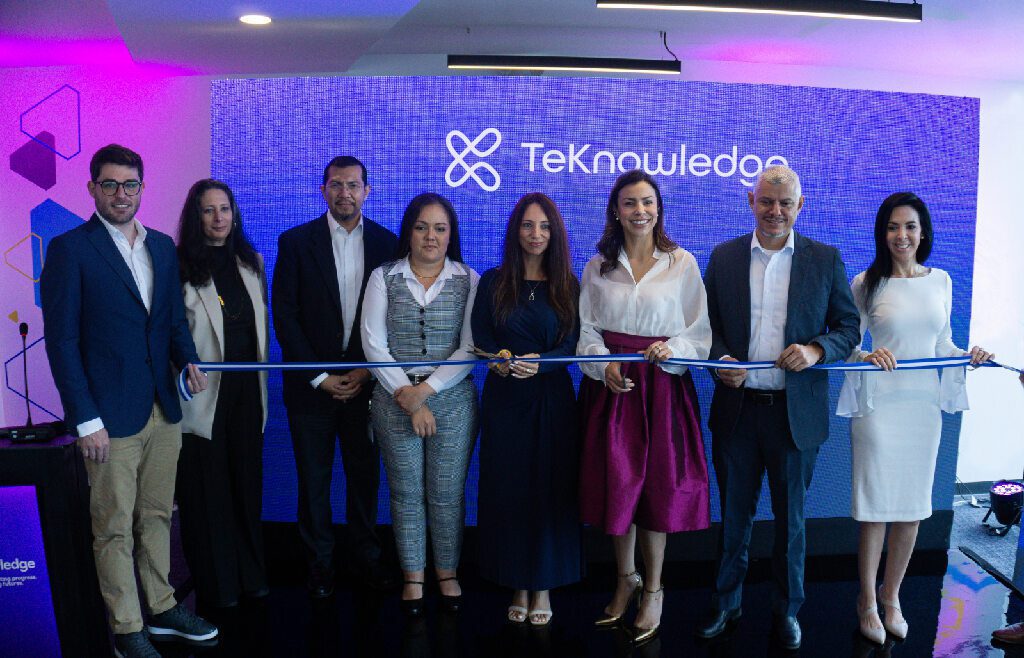Stay Ahead with Expert-Led Insights
Navigating Complexity. Driving Progress. Creating Lasting Impact.
Welcome to the TeKnowledge Insights hub! Here, you’ll find a blend of strategic perspectives, real-world case studies, and expert analysis designed to empower organizations to navigate challenges and seize new opportunities.
Explore the insights that matter most. Stay informed, gain new perspectives, and discover how businesses worldwide are unlocking new opportunities with TeKnowledge.
Stay Ahead with Expert-Led Insights
Navigating Complexity. Driving Progress. Creating Lasting Impact.
Welcome to the TeKnowledge Insights hub! Here, you’ll find a blend of strategic perspectives, real-world case studies, and expert analysis designed to empower organizations to navigate challenges and seize new opportunities.
Explore the insights that matter most. Stay informed, gain new perspectives, and discover how businesses worldwide are unlocking new opportunities with TeKnowledge.
All Categories
The latest developments, strategic partnerships and milestones.
- Thought Leadership
What a year it’s been for all of us at TeKnowledge! Since our unified brand launch in April 2024, we’ve reached remarkable milestones that speak to the synergy of our three formerly separate companies now working as one. This success wouldn’t be possible without the dedication, creativity, and resilience of our incredible teams—and the trust and collaboration of our customers and vendor partners, who have embraced our vision and helped bring it to life.
Though our brand is still in its early days, the combined expertise and commitment of our 6,000 team members have already begun shaping an extraordinary future for everyone we serve. Below are just a few highlights from 2024—glimpses of the global progress we’ve powered together. Thank you for being part of this journey, and for empowering us to pursue a more innovative, resilient tomorrow.
Growing the Team from Within
- El Salvador & Honduras
We launched Managed Services in El Salvador, sparking new business and delivering personalized service. In Honduras, our newly opened entity is actively exploring cybersecurity collaborations with major national institutions, fuelling local talent growth at every step.
- UAE
Establishing ourselves in Dubai and laying foundations in Abu Dhabi positions us in a region that values forward-thinking solutions. This expansion also creates fresh opportunities for strategic partnerships and deeper global engagement.
- Nigeria
Now home to our cybersecurity operations center, Nigeria has quickly become a success story—further underscored by being named Africa’s Most Innovative Tech Support Services Company of the Year 2024. This achievement paves the way for broader security offerings across Africa’s dynamic landscape and its promising enterprise sector
Empowering Clients Through Innovation
- Digital Centre of Excellence in Qatar
In collaboration with Microsoft and the Qatar Ministry of Communications and Information Technology, we’re training thousands of government employees on AI and Microsoft Copilot. This pilot project aims to redefine how public organizations learn, collaborate, and operate more efficiently. We’re grateful to both the Qatari government and Microsoft for making this journey so impactful.
- Carahsoft
Our latest partnership with Carahsoft extends across Africa and the Americas, delivering advanced support for cutting-edge technologies. This collaboration showcases our capability to serve clients on a global scale while unlocking opportunities for shared innovation and growth. Carahsoft, we deeply value your trust and are excited to achieve great things together.
- National-Level Cybersecurity
By partnering with an independent nonprofit organization, we’ve moved from concept to a nation-scale Security Operations Center, showcasing how we deliver sustainable, high-impact solutions. Working side by side with local experts ensures we meet immediate objectives while championing ongoing security measures.
Championing Sustainability & Skilling
Integrating responsible practices into our solutions aligns with Nikon’s global vision—and ours. Nikon, thank you for partnering with us to ensure technology actively contributes to a healthier planet and society.
- Training Future Talent
From upskilling Qatari government employees on AI tools to preparing young Costa Ricans—72% of whom are women—for cloud-based roles, we remain committed to closing digital skill gaps. We’re also proud of our partnership with Omantel, where a data science initiative is empowering their teams to excel in a fast-evolving digital arena. Omantel, your forward-thinking mindset has made our work especially fulfilling.
- Recognition, Awards, & Global Expertise Sharing
We’re honored by accolades like the EC-Council ATC Circle of Excellence Award for cybersecurity education, as well as recognition in Nigeria for innovative tech support. Beyond awards, our focus remains on connecting governments and enterprises worldwide—fostering sustainable, inclusive digital progress for all.
A People-First Culture
At TeKnowledge, our people-first ethos guides every project, from colleague interactions to customer engagements. By building trust, showing empathy, and encouraging personal and collective growth, we ensure that collaboration and curiosity define the solutions we provide. This commitment to caring, embracing diverse talents, and prioritizing continuous learning enables us to deliver exceptional results every day.
Looking Ahead to 2025
As we advance on our journey, look forward to a bolder TeKnowledge brand, refined offerings, and a more cohesive go-to-market strategy—reinforcing our commitment to delivering high-value solutions. Stay tuned for updates on our new alliances in cybersecurity, AI, and customer experience. True to our belief that “growth for TeKnowledge means growth for our people,” we remain dedicated to prioritizing internal talent for upcoming projects, ensuring that personal achievements align with organizational advancement.
To Our Customers and Vendor Partners: Your trust and collaboration power our mission to bring transformational technology to every region we serve. Thank you for backing us every step of the way.
Here’s to 2025, where we’ll push new boundaries, reach further horizons, and celebrate our most essential strength—you, the people of TeKnowledge.
- Thought Leadership
Everything You Need to Know About the Zero Trust Model of Cybersecurity
In today’s fast-changing digital world, information security has become a major concern. Organizations face constant threats of cyberattacks and data breaches, which can jeopardize their reputation, assets, and clients’ trust. To address these challenges, the Zero Trust model has emerged, shifting from the traditional “trust but verify” approach to a “never trust, always verify” mentality. This model is based on the principle that no person, device, or application can be automatically trusted within a network, requiring continuous validation at every access point.
In this blog we interview our cybersecurity expert and trusted Chief Cybersecurity Architect, Anat Garty about Zero Trust.
What are the Key Elements of Zero Trust?
- Granular Authentication and Authorization: Each user, device, or application must be individually validated before accessing specific resources. Permissions and privileges are assigned based on the entity’s role and needs.
- Network Segmentation: The network is divided into smaller, isolated segments to limit the reach of an attack and minimize its impact.
- Context-Based Security Policies: Access decisions are made based on factors like location, device, time of day, and historical behavior.
- Rigorous Verification Strategy: Every access request is evaluated and verified without assumptions about prior reputation.
- Continuous Visibility and Monitoring: Security monitoring solutions provide complete visibility into network activities, detecting anomalous behavior and threats in real time.
What are the Benefits and Advantages of Using this Model?
By requiring authentication and validation at each access point, Zero Trust reduces the attack surface, preventing advanced threats such as lateral movement of attackers.
By adopting this model, organizations gain a clear understanding of their most valuable resources, allowing them to establish granular access controls and define precise rules for connecting to critical assets. This reduces the attack surface, strengthens data protection, improves incident response capabilities, aligns with compliance requirements, and improves overall risk management.
What are the Common Challenges and Obstacles?
Implementing a Zero Trust strategy involves significant changes to an organization’s security infrastructure and policies. It requires careful planning, coordination among multiple teams, and a thorough analysis of existing infrastructure. The starting point should be the identification of critical assets and understanding how users interact with them:
The first step in a Zero Trust journey is to identify the organization’s critical assets and map out how users access and interact with them. This ensures that authorization requirements align with actual use cases, improving both security and user experience. Once this foundation is established, other challenges, such as addressing legacy systems, come into focus. Legacy systems may lack the capabilities needed for granular access controls, continuous monitoring, and secure authentication. Upgrading or integrating these systems requires careful planning and can be time-consuming, but it is a necessary step to ensure compatibility with Zero Trust architecture.
What Tools and Technologies are Needed to Support Zero Trust?
Successful implementation of Zero Trust relies on various tools and technologies, such as multi-factor authentication, identity and access management (IAM) solutions, next-generation firewalls (NGFW), software-defined network (SDN) security, and security analysis and monitoring tools. Anat Garty provides a practical guide for adopting Zero Trust:
To correctly adopt this model, it is recommended:
- Define a clear Zero Trust strategy aligned with the organization’s objectives and compliance requirements.
- Identify and prioritize critical assets, such as sensitive data and applications.
- Define roles and their required access and authorization levels.
- Implement strict access controls based on the principle of least privilege.
- Use micro-segmentation to limit lateral movement and contain threats.
- Use encryption to protect data in transit and at rest.
- Improve visibility to continuously monitor and analyze network traffic, user behavior, and access patterns.
- Foster a culture of safety awareness and education.
- Encourage collaboration and communication between teams.
- Incorporate the Zero Trust approach into change management processes.
- Regularly evaluate and improve implementation through audits and testing.
A Look into Zero Trust’s Future
The adoption of Zero Trust is expected to become more widespread as organizations seek robust security solutions. Integrating artificial intelligence (AI) and machine learning (ML) will enhance threat detection and response capabilities, while the increasing use of cloud solutions will shape Zero Trust strategies to address specific challenges in cloud environments.
By following these practices, organizations can lay a solid foundation for a successful Zero Trust model, improving overall security and resilience against cyber threats.
If you need more information on cybersecurity managed services, you can take a look at https://teknowledge.com/cybersecurity/ or contact us https://teknowledge.com/contact/.
About Anat Garty
Anat is a Cybersecurity expert with over 20 years of experience in managing Security Operations Centers (SOC) at national and sectoral levels in various parts of the world.
She has held key roles both on the client side, as Chief Information Security Officer (CISO), and on the provider side, in positions such as Program and Account Manager, and Chief Cybersecurity Architect at renowned companies like AWS.
Her career highlights a strong ability to lead and protect organizations against complex cyber threats.
- Case Studies & Use Cases
2024 has been a year of significant milestones for TeKnowledge in Qatar. It has equipped 3,280 individuals with next-generation digital capabilities in Cloud Computing, AI, Cybersecurity, and more.
Partnering with global leaders like Microsoft, EC-Council, and PeopleCert, we’ve delivered impactful training, awarded 246 certifications, and, most importantly, supported Qatar’s Vision 2030. Our holistic approach integrates skilling, advisory, adoption, and managed services, empowering organizations to achieve sustainable growth and drive digital transformation.
Together with our valued stakeholders, we are shaping a skilled, future-ready workforce for Qatar’s advancement. In collaboration with leading global technology partners, we have spearheaded national skilling programs that bridge the gap between traditional competencies and future-ready capabilities. Our work extends across the government, commercial, and education sectors, equipping thousands with in-demand skills while contributing to economic growth.
We proudly announce the establishment of our AI Academy, Cybersecurity Academy, and Digital Academy. These academies are designed to provide specialized training and certifications in their respective fields, ensuring that professionals in Qatar are equipped with the latest knowledge and skills. Through our digital skilling programs, 1,579 Qatari citizens benefited out of the 3,280 individuals trained by TeKnowledge in the past year alone. Cybersecurity stands out among the specialized focus areas, with over 1,183 students acquiring critical knowledge and certifications to reinforce their professional journey. As we are experiencing a skill gap in this field at a global level, this gives Qatar professionals an exciting opportunity to stand out. Our success is built on robust partnerships with globally recognized accreditation bodies and IT leaders like the above mentioned, plus others like Cisco, CompTIA, VMware, leaders like the above-mentioned, plus others like Cisco, CompTIA, VMware, CertNexus, and PECB. These collaborations enable us to deliver a range of certified training programs, ensuring learners are equipped with cutting-edge knowledge in areas such as Cloud Computing, Artificial Intelligence (AI), Data Science, Network Engineering, IT Infrastructure, Software Development, Project Management, Cybersecurity, Digital Marketing, Business Applications, and IoT.
Driving Digital Transformation: The Future of Human Development in Qatar – YouTube
Our learning journeys are tailored to meet the specific professional goals of our students, leveraging our partnerships with globally recognized accreditation bodies and IT leaders. Our certified instructors, with 15-20 years of industry expertise, combine real-world case studies, hands-on labs, and gamification techniques to create dynamic and engaging learning environments. With instructor ratings averaging between 4.5 and 4.9 and learner satisfaction scores between 4.4 and 5.0 out of 5, we consistently deliver world-class training experiences. We take pride in being an authorized Pearson VUE test center, enabling learners to earn prestigious certifications from providers like Microsoft and CompTIA.
We’re thrilled to be part of Qatar’s journey and to contribute to the GCC’s digital transformation. We look forward to the exciting opportunities that lie ahead!
- News & Company Updates
We’re thrilled to share some incredible news! TeKnowledge has been honored with the prestigious EC-Council ATC Circle of Excellence Award!
Out of over 2,380 training partners across 150+ countries, we’ve been recognized as one of the world’s top training centers, making a meaningful impact in the cybersecurity domain. This award is a true testament to our team’s hard work, dedication, and commitment to empowering students and driving excellence in cybersecurity education. This is all possible because of our phenomenal team, whose relentless pursuit of excellence made this achievement possible. This is not just a milestone but a steppingstone toward even greater success.
EC Council is the world’s largest cyber security technical certification body, having trained and certified over 200,000 information security professionals globally that have influenced the cyber security mindset of countless organizations worldwide.
We proudly deliver some of EC-Council’s most sought-after trainings and courses, including:
- Certified Ethical Hacker (CEH)
- Server & Web Forensic (CHFI)
- Incident Respond (CIH)
- Threat Intelligence (CTIA)
- Security Operations (CSA)
- ICS/SCADA Cybersecurity
- Application Security Engineer (CASE)
- SOC Analyst
- ECSS: Certified Security Specialist
- EC Council Certified Chief Information Security Officer (CCISO)
- EC Council Certified Network Defender (CND)
- EC Council Certified Penetration Testing (CPENT)
In addition, we’re already delivering the latest version of the Certified Ethical Hacker program (CEH v13), launched just two weeks ago! As EC-Council’s flagship course, the CEH is designed to address the cybersecurity skills gap, empowering professionals with cutting-edge, AI-driven capabilities to stay ahead in today’s evolving digital landscape.
As we celebrate this remarkable achievement, we remain committed to empowering professionals and organizations with world-class cybersecurity training. Together, let’s continue to innovate, inspire, and build a safer digital world.

- News & Company Updates
TeKnowledge Featured in Prestigious Media Outlet “La República”. Read the original article in Spanish here, or find the English translation below:
The company takes a comprehensive approach by combining security audits and penetration testing to correct vulnerabilities in organizations.
Artificial Intelligence (AI) has become a key tool driving the evolution of various industries in Costa Rica, including health, retail, finance, and telecommunications. These sectors are adopting AI technology to optimize operations, enhance customer experiences, and automate processes. However, with this progress comes a significant challenge—ensuring the safety of the data that feeds these models.
In response to this, TeKnowledge, a pioneering company in cybersecurity, has assumed a vital role in providing advanced protection against cyberattacks targeting AI technologies. AI has revolutionized operations in industries like telecommunications, where real-time AI models analyze queries, improving user satisfaction and optimizing response times. But this evolution also introduces new threats: the need to safeguard sensitive data has become paramount.
“AI models are powerful, but their effectiveness relies heavily on the security of the data they process. A breach in this data can result in massive repercussions, both in terms of reputation and operational disruption,” explained Anat Garty, Chief Cybersecurity Architect at TeKnowledge.
The average cost of a data breach in Latin America exceeded $4.35 million in 2023, according to an IBM report. This emphasizes the importance of integrating security measures at every phase of an AI model’s lifecycle.
“Many AI models are developed with efficiency in mind, not security, making them vulnerable to attacks. Our mission is to shield these systems,” added Alberto Herrera, Proactive Defense Manager at TeKnowledge.
A Comprehensive Approach to Data Protection
“Protecting AI models is not just about installing software. When deployed securely, TeKnowledge has developed a holistic approach that includes security audits and penetration testing to identify and mitigate gaps before they can become threats. This proactive stance ensures that AI models operate securely, without compromising data integrity. TeKnowledge ensures businesses can trust their AI models without worrying about halting operations due to security risks. AI has the potential to transform industries, but its true power is only realized when implemented securely,” concluded Jeannie Bonilla, LATAM Business Lead at TeKnowledge.
Key Facts
· $4.35 million is the average cost of a data breach in Latin America in 2023, according to an IBM report.
· 48% of organizations using AI have experienced cyberattacks related to vulnerabilities in their models, according to an Accenture report.
· The last two years have seen rapid adoption of AI technologies and a rise in the sophistication of cyberattacks.
· 100% of the AI models at TeKnowledge undergo security audits and penetration testing before deployment.
- Events & Webinars
As the global cybersecurity landscape evolves at an unprecedented pace, TeKnowledge remains at the forefront of innovation and protection. This was evident at the recently concluded Cyber Secure Nigeria 2024 Conference, hosted by the Cyber Security Experts Association of Nigeria (CSEAN) in Abuja. Held from September 25th to 26th, the event brought together cybersecurity professionals, industry leaders, and thought leaders, all converging under the theme: “AI at the Forefront of Digital Defense.”
Not only were we a proud sponsor of this event, we took an active role in the discussions and knowledge sharing. Our CyberNexus Village Square was a key highlight, with a packed program leveraging the expertise of top cybersecurity professionals to exchange ideas and explore how artificial intelligence (AI) is reshaping digital defense.
Tackling Cybersecurity Challenges Through Expert Insights
The TeKnowledge CyberNexus Village featured a key panel discussion titled “Importance and Challenges of Cybersecurity in Today’s World,” which included top cybersecurity minds like Adedoyin Ademola, Chief Information Security Officer at the Central Bank of Nigeria, Philip Aiwekhoe, Chief Information Security Officer and Data Protection Officer at NPF Microfinance Bank Plc and Etuk Emmanuel, Lead Business/Technology expert at the World Trade Center. These leaders shared valuable insights into the evolving nature of cybersecurity threats and the growing necessity for proactive defense strategies, touching on AI-powered cyber risks, mitigation of these risks as well as the impact of challenges of governmental policies for cybersecurity in Nigeria. The discussions not only highlighted the complex nature of emerging threats but also emphasized the need for collaborations between public and private sectors to safeguard digital assets.
Bridging the Cybersecurity Skills Gap
In addition to the panel, Mr. Ifeanyi Jude Muonagor, Head of Cybersecurity Operations at the Central Bank of Nigeria, led an insightful session on “Cybersecurity Skills Gap and Talent Management.” This session explored the pressing issue of the shortage of skilled professionals in the Nigeria cybersecurity sector. Mr. Muonagor presented practical strategies for tackling this issue, emphasizing the importance of continuous upskilling to stay ahead of rapidly evolving cyber threats. This theme aligns closely with TeKnowledge’s mission to bridge the cybersecurity skills gap across the continent.
TeKnowledge’s Commitment to Cybersecurity Innovation
Reflecting on the company’s involvement, Motunrayo Ayo-Akwe, Senior Marketing Manager for Africa at TeKnowledge, stated: “Our presence at the Cyber Secure Nigeria 2024 Conference underscores TeKnowledge’s dedication to addressing the cybersecurity challenges Africa faces today. By engaging with industry leaders and experts, we reinforced our commitment to innovation and to bridging the cybersecurity skills gap across the continent.” TeKnowledge’s sponsorship of the Cyber Secure Nigeria 2024 Conference not only highlighted our cybersecurity expertise but also showcased our broader vision of supporting Africa’s digital transformation journey.
The Road Ahead
As Nigeria’s technology ecosystem continues to grow, TeKnowledge is poised to lead the charge in AI innovation, helping government and enterprises overcome the hurdles of digital transformation both today and in the future, through meaningful advisory and consultancy, advanced technical capability and skilling, and comprehensive technical managed services on a grand scale. Our unwavering dedication to propelling our customers’ strategic goals through technical advancement places them at the vanguard of digital evolution, ensuring they not only keep pace but outstrip the competition.
Stay tuned for more updates as TeKnowledge continues to lead the way in securing the digital future of Africa.
- News & Company Updates
TeKnowledge is proud to announce the appointment of Nidal Abou-Ltaif as Chief Revenue & Transformation Officer, marking a pivotal step in the company’s ambitious growth and expansion strategy.
“We are excited to welcome Nidal to the team,” said Aileen Allkins, President & CEO of TeKnowledge. “His visionary leadership and proven ability to drive innovation and assemble customer focused teams are exactly what we need to accelerate our next phase of growth. Nidal’s extensive experience in guiding governments and enterprises through complex transformations and security challenges makes him uniquely positioned to lead our efforts. His expertise in CX transformation, cybersecurity, AI, and technical skilling will ensure we deliver impactful solutions that drive success for our clients worldwide.”
Commenting on his new role, Nidal said, “I’m excited to join TeKnowledge and contribute to its ongoing journey of innovation. I look forward to helping our clients and stakeholders realize their full potential. Joining TeKnowledge will allow us to scale AI adoption, deliver top-tier security, and empower individuals and organizations through nation-wide skilling programs to support their digital Journey. Our focus on customer-centricity will guide us as we deliver exceptional value.”
TeKnowledge partners with governments, businesses, and technology providers to help them navigate today’s complex digital landscape. Supported by a global team of over 6,000 technical experts, the company is a globally trusted services and learning partner for the world’s top tech providers, handles more than 100,000 tech cases monthly and resolves over 14,000 cyber incidents annually through their 19 locations world-wide.
Nidal joins TeKnowledge with more than two decades of leadership experience at Avaya, where he successfully spearheaded growth and transformation initiatives. Renowned for his customer-focused approach and commitment to leveraging technology for a positive impact, he has been widely recognized for his contributions to industry transformation. Prior to Avaya, Nidal held leadership positions at AT&T and NCR.
Recently, Cytek Security, Tek Experts, and Elev8 merged to form TeKnowledge, uniting their collective strengths into a single, unified brand offering end-to-end digital transformation services.
Nidal is based in Dubai, UAE.
- News & Company Updates
TeKnowledge had the privilege of participating in the Msheireb Commercial Majlis, an influential event shaping the future of business, culture, and community in Doha. This event brought together key decision-makers, fostering collaboration and inspiring forward-thinking conversations, making it an ideal platform for us to connect with Qatar’s innovators.
Held at the iconic Msheireb Downtown Doha, the event highlighted the remarkable growth of the district, which has become a hub for offices, retailers, and residents shaping Qatar’s future. For TeKnowledge, being part of this vibrant community reflects our commitment to leading Digital Transformation and Learning in the region.
A Hub for Innovation
TeKnowledge is more than just a digital learning provider. With the launch of our Digital Center of Excellence (DCE) in March 2022, under the patronage of His Excellency Mr. Mohammed bin Ali bin Mohammed Al Mannai, Minister of Communications and Information Technology, we reinforced our mission to be a key driver in the Middle East’s digital journey. In partnership with MCIT and Microsoft, DCE was established as a hub where technology, creativity, and innovation converge.
The DCE is not just a place—it symbolizes the potential of human ingenuity and technology working together. It’s where we empower organizations to thrive in today’s fast-evolving digital landscape. Our aim is to foster innovation, drive new ideas, and support enterprises in navigating digital challenges while preparing for the future.
Leading in Digital Skilling and Transformation
“TeKnowledge’s role as a Digital Center of Excellence is grounded in our commitment to enable governments and businesses globally. We provide top-tier digital skilling, cybersecurity expertise, and managed services at scale to keep our clients ahead in the digital era. We don’t just deliver services; we create tailored solutions that drive progress,” said Rania ElKhoury, Country Learning Operations Leader.
As one of the first companies to join the Msheireb community in 2022, TeKnowledge has solidified its position as a leading global skilling partner, contributing to Qatar’s knowledge economy and preparing the workforce for the challenges of today and tomorrow.
A Gathering of Visionaries
The Msheireb Commercial Majlis brought together visionary leaders from various industries, including Schneider Electric, American Express, QIIB, Media City, Snapchat, Qatar Tourism, and Virgin. This dynamic space for collaboration and discussion is one that TeKnowledge is proud to be part of, as we continue to push the boundaries of Digital Transformation.
Join us on this journey as we drive innovation, create opportunities, and contribute to Qatar’s future as a knowledge economy leader.
- Events & Webinars , Thought Leadership
We are excited to announce our entry into the Salvadoran market as a global leader in technology services, specializing in artificial intelligence, cybersecurity, and advanced technical support. This expansion marks a significant step in our mission to foster innovation, growth, and talent development in the Central American region.
On September 25th, 2024, we hosted the opening event at our new base of operations in Millennium Plaza, San Salvador. The gathering welcomed key representatives from the Salvadoran Legislative Assembly, the Secretariat of Commerce and Investments, the Ministry of Economy, Invest In El Salvador and many other esteemed organizations including the Embassy of Spain, and local chambers of commerce.
During the event, María Balbás, our Executive Vice President, and Jeannie Bonilla, LATAM Business Lead, shared TeKnowledge’s vision and plans for El Salvador. Alberto Acosta, Undersecretary of Commerce and Investment, and Mario Padilla, Executive Director of the Salvadoran Chamber of Information and Communication Technologies (CASATIC), highlighted the exciting opportunities this expansion presents for the country and reinforced the Salvadoran government’s vision to transform El Salvador into the “Technology Hub of the Americas.” Their remarks emphasized how this vision will stimulate innovation and local growth in the ICT sector while attracting global investments.
Mario Padilla expressed his optimism, stating: “The arrival of TeKnowledge in El Salvador represents a valuable investment in our talent and our economic future. This expansion will not only create highly skilled jobs but will also attract more technological investments, positioning El Salvador as a prime destination for future projects.”
As the event progressed, Anat Garty, our Chief Cybersecurity Architect, shared insights on the most pressing cybersecurity challenges faced by nations today and how TeKnowledge is poised to address them with innovative cyber solutions.
The event culminated in a symbolic ribbon-cutting ceremony with María Balbás, Jeannie Bonilla, Elizabeth Vega (Site Manager), Alberto Acosta, Mario Padilla, and Jessica Bukele (Deputy Director of Investment Promotion at INVEST), officially inaugurating our new offices in El Salvador.
TeKnowledge has already integrated 100 Salvadoran engineers into our global network and plans to hire over 200 local employees annually. This investment is made possible thanks to the favorable conditions created by the government’s Law for the Promotion of Innovation and Technological Manufacturing.
Our commitment to El Salvador goes beyond job creation. We aim to elevate the country’s technological capabilities and make it a key player in Central America’s growing tech landscape.
We’re thrilled to be part of El Salvador’s digital transformation and are looking forward to all the exciting opportunities that lie ahead!









